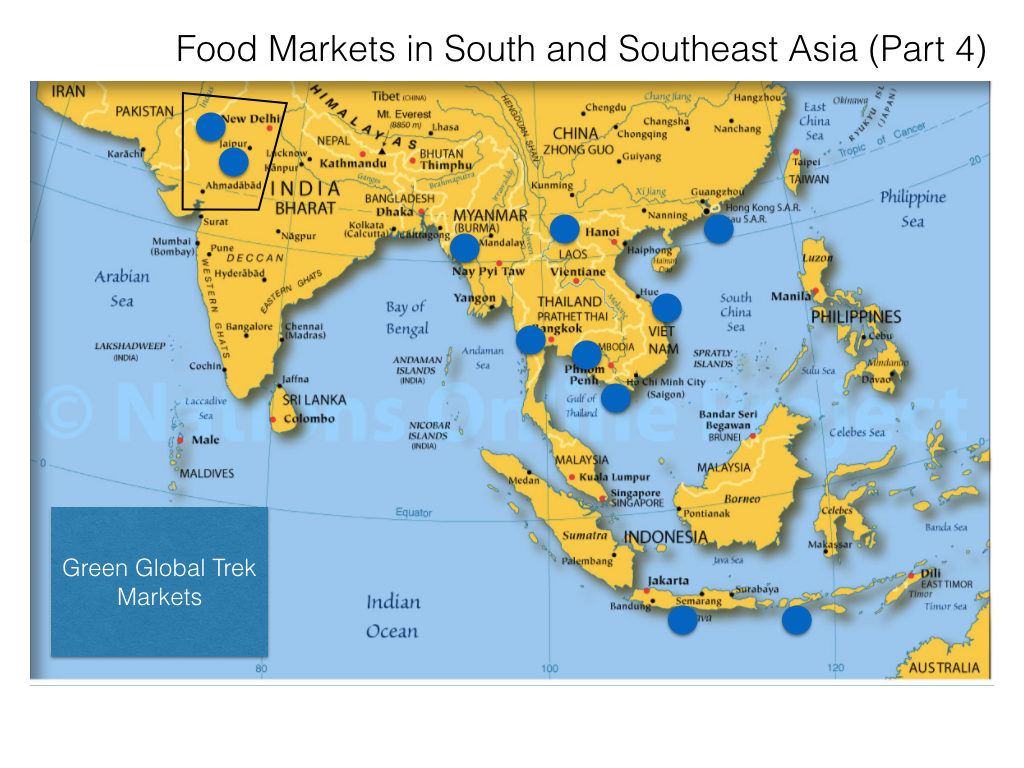
We have travelled to India several times, but the most recent time was particularly memorable, as we timed our visit to coincide with the annual CAMEL trading fair in Pushkar…. A fabulous, exotic, one of a kind event, that brings people from all around the region to trade camels, livestock and show case prized horses.
But first, we land in Mumbai.
Mumbai
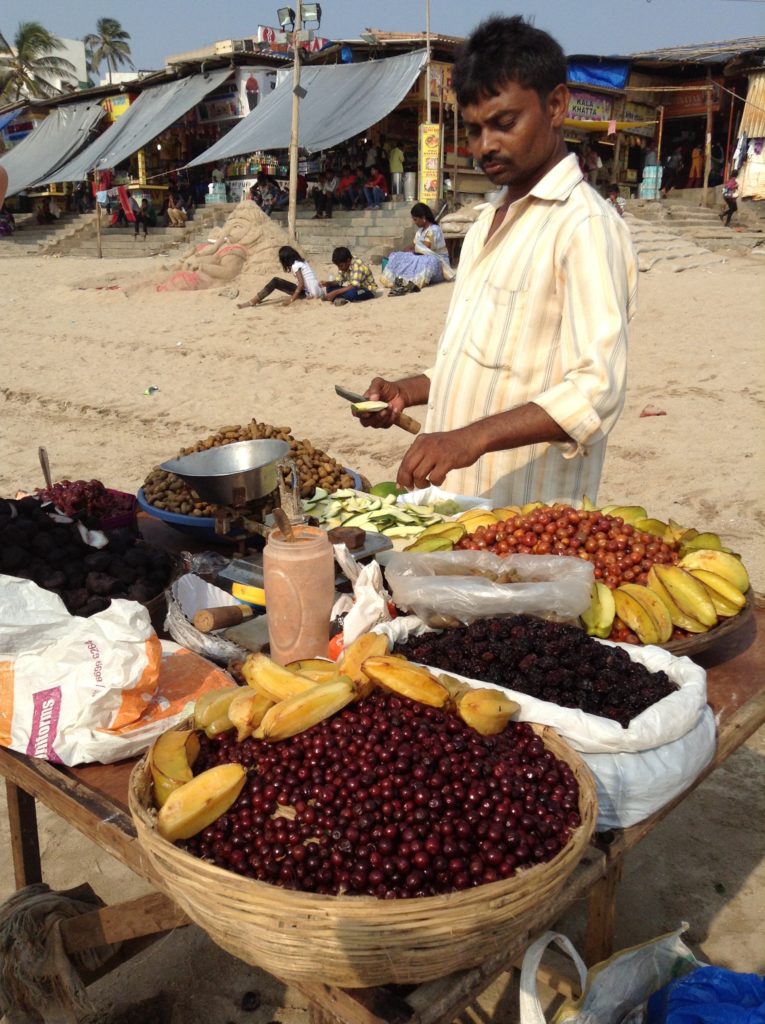
The beach front in Mumbai serves as a market of sorts… With ambulent vendors selling a variety of fruits and prepared foods. Here an assortment of berries and star fruit.
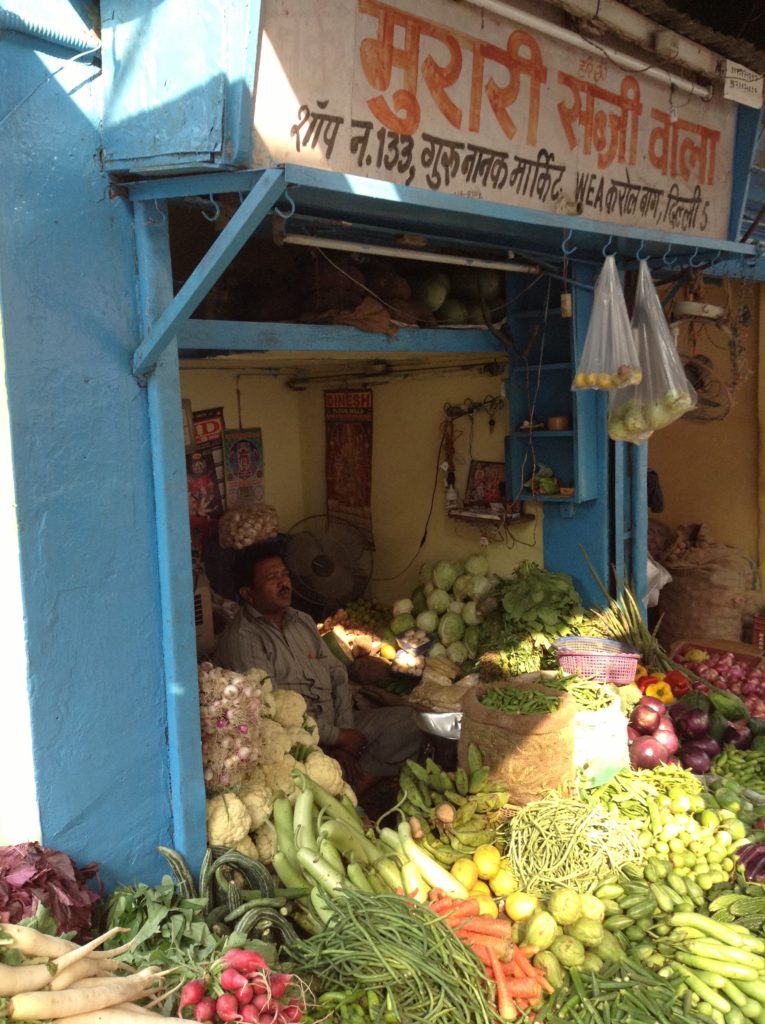
Near where we are staying, there is a small market chockfull of little storefronts overflowing with produce, onto the sidewalk.
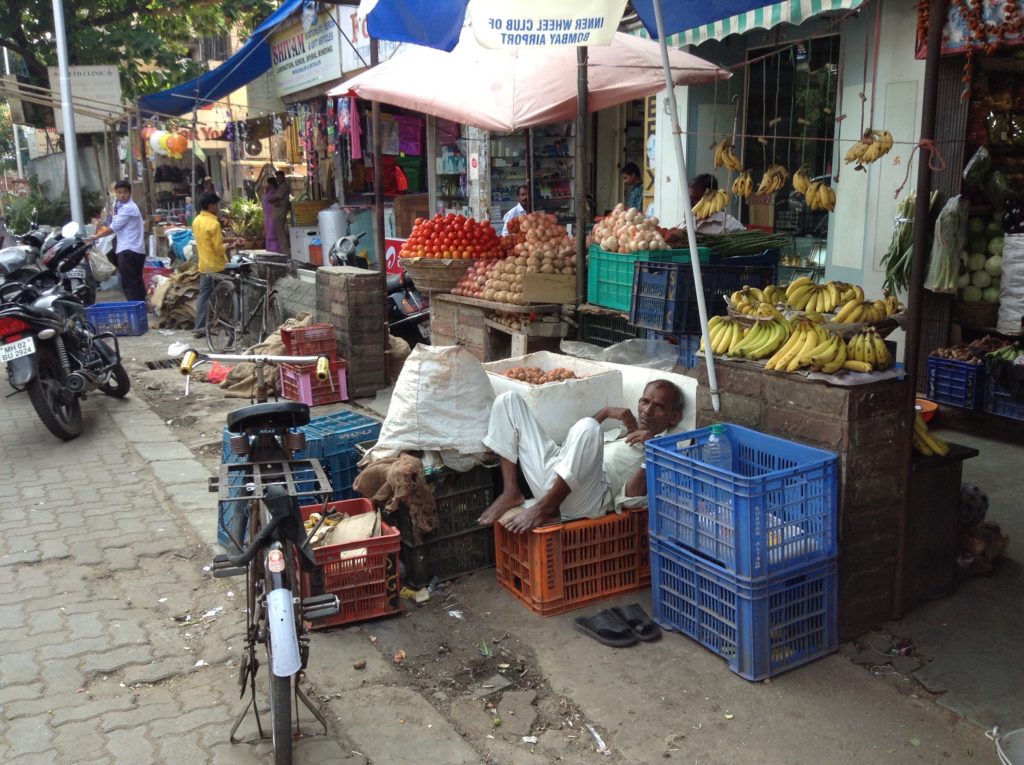
As we walk through this little market checking out what local fruit there is to be had, most of the vendors are taking their siesta during the heat of the day.
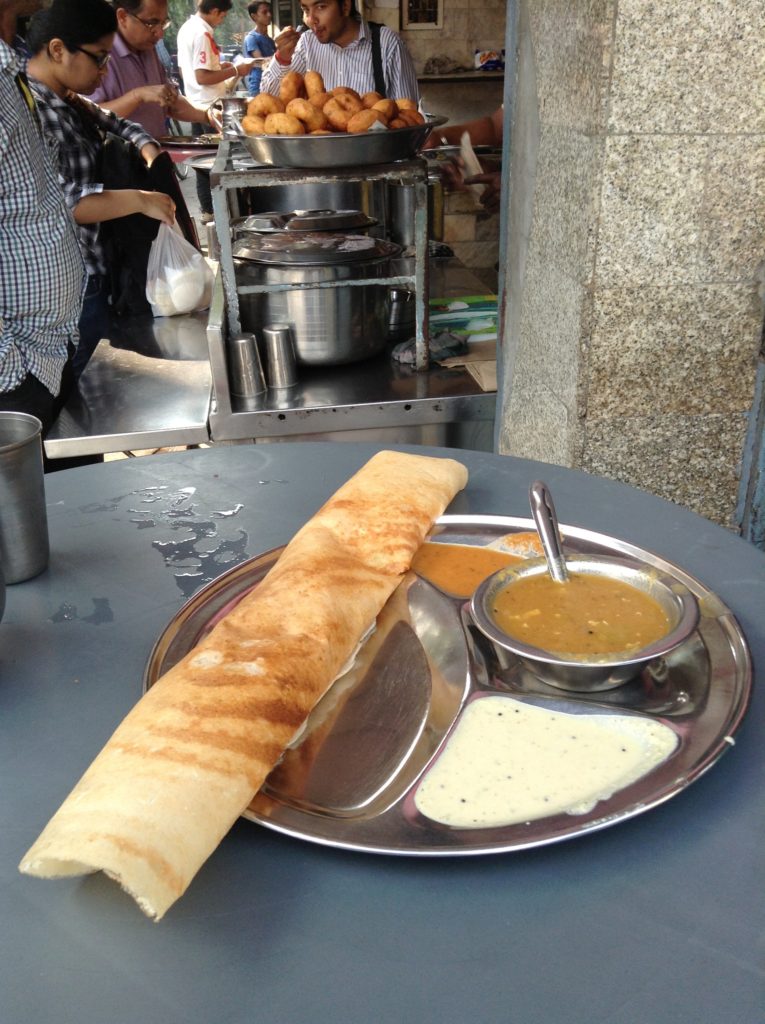
Ahh the delectable paper dhosa, a paper thin crispy “crepe”, found throughout India ~ each region offers a different take on the dhosa. Makes for a terrific snack during the day. Here served with a few different types of dahl (lentils).
Market near Jaipur, India
Making our way toward Pushkar, we stop in Jaipur, one of our favorite cities and the capital of Rajahsthan.
Jaipur is also known as the “Pink City” due to the prevalence of pink hued sandstone buildings ~ palaces, forts and temples.
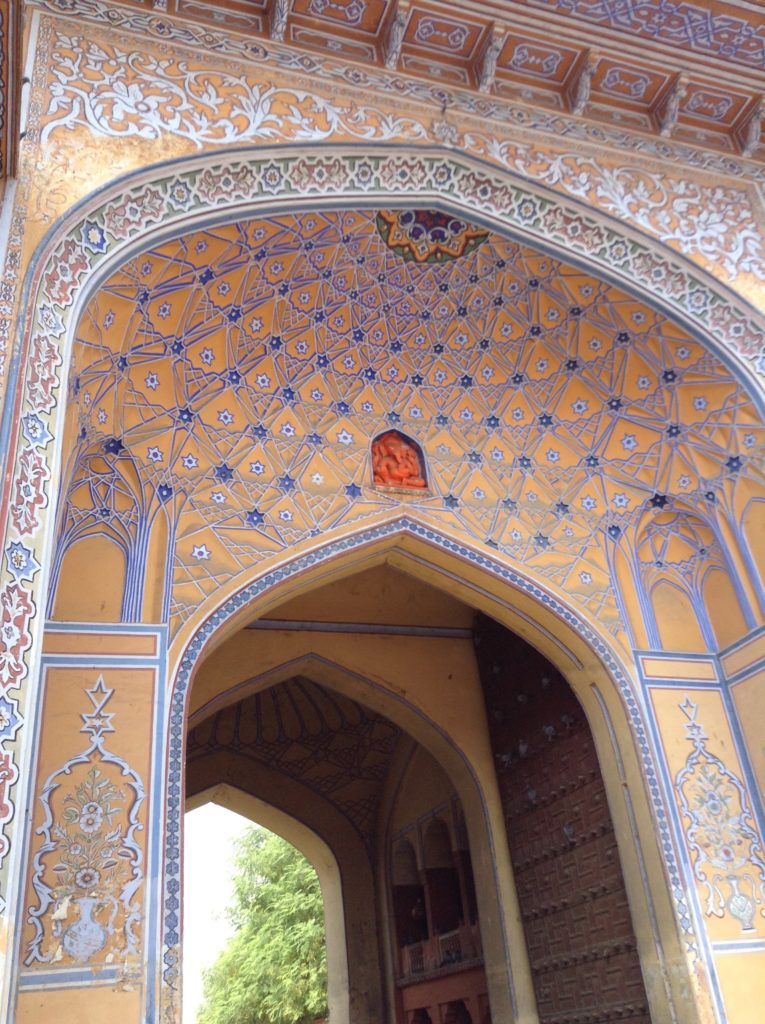
One of the reasons we love this region is for the magnificent architecture. A grandiose arched gate leading to the City Palace, offers just a glimpse of the treasures that can be found here.
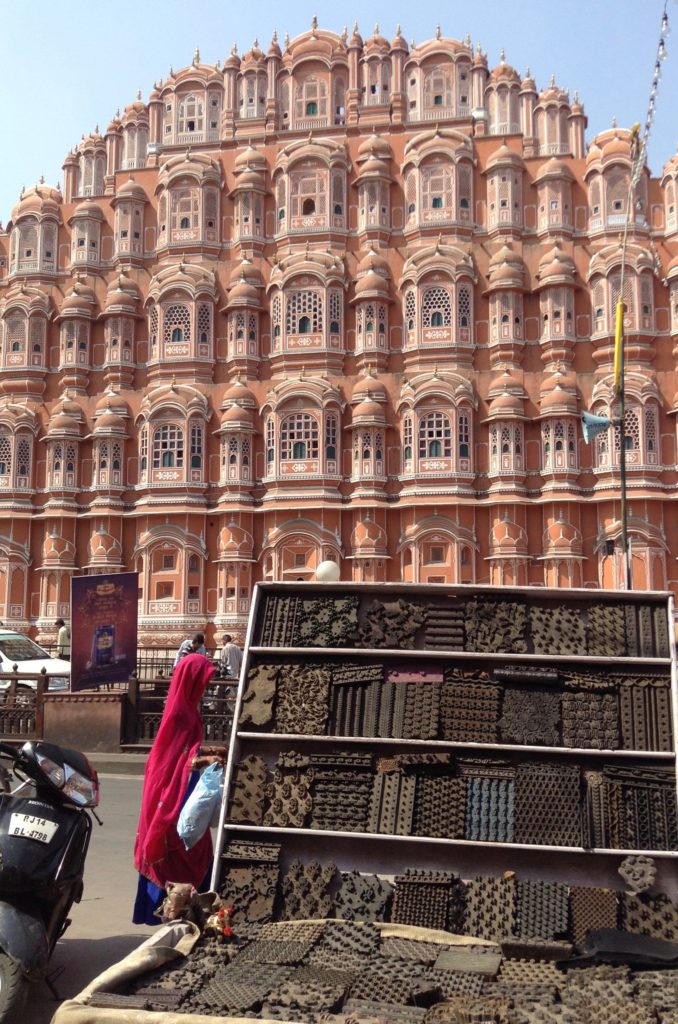
Antique wooden blocks from the printing press in front of the Hawa Mahal (“The Palace of Winds”). Constructed of sandstone and sitting at the entrance of the City Palace, this landmark building allowed the women of the court of the Maharaja to observe the activities in the street below, without being seen themselves.
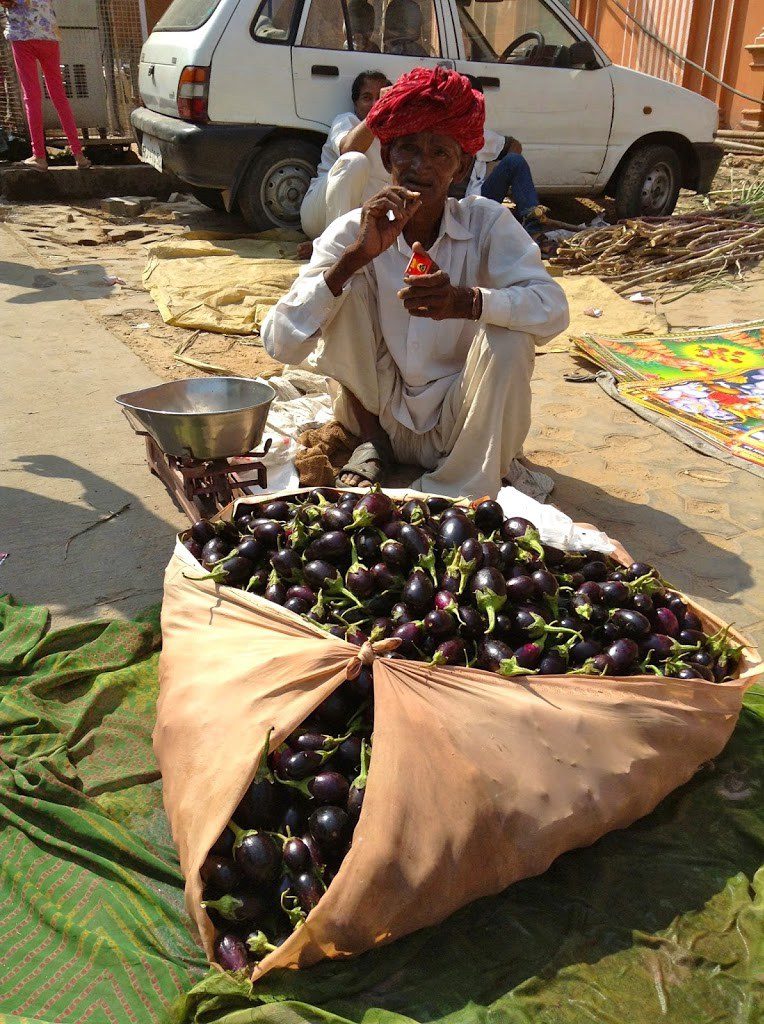
It feels as though the entire city is a giant market. Everywhere people have “set up shop”… to hawk their wares. Here, a baleful of deep aubergine eggplants.
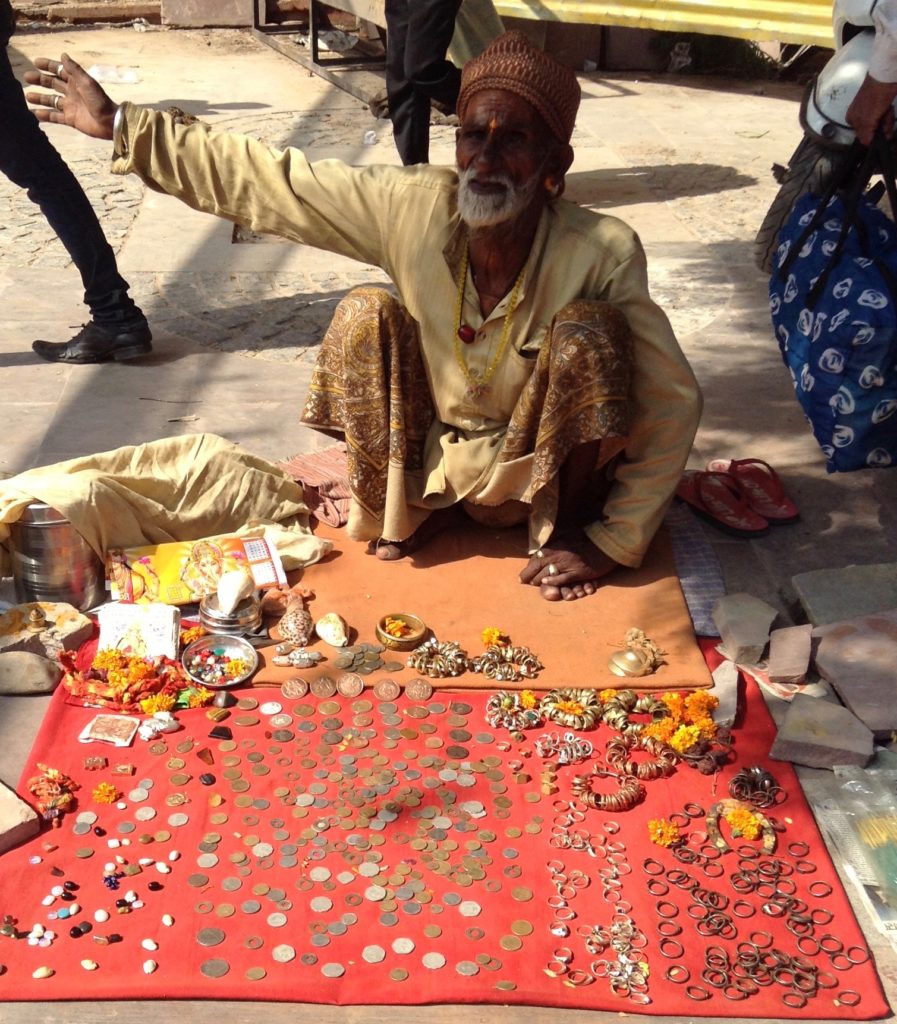
In amongst the fruits and vegetables, there are all sorts of other interesting items being sold. This man offers a collection of antique coins and rings.
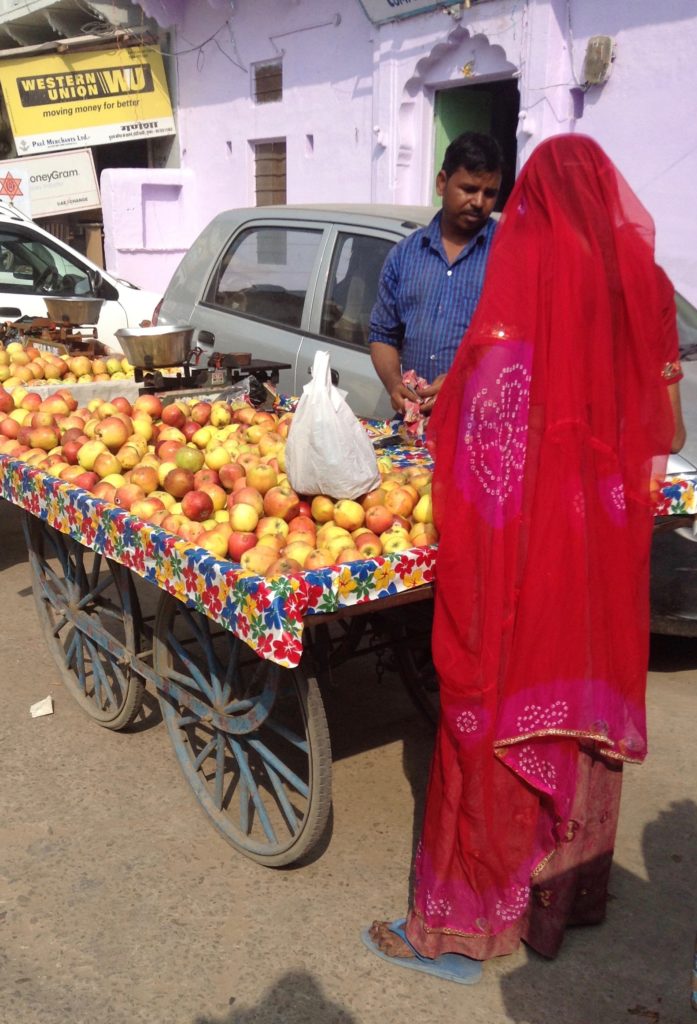
On the outskirts of the city we find wagon fulls of fruit, which are contrasted against the vivid colors of the saris of the women.
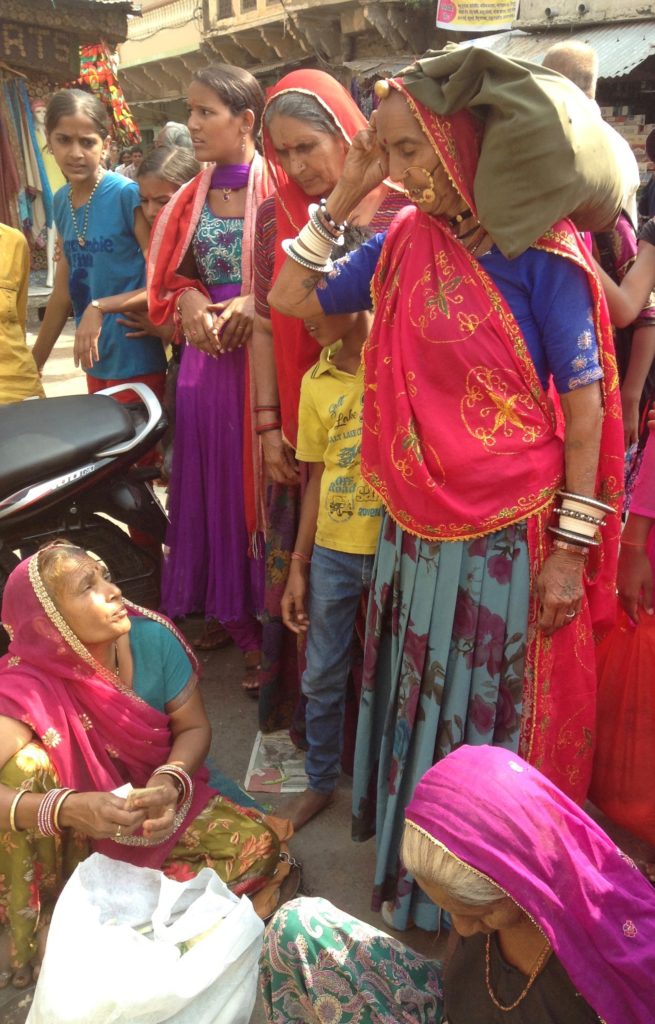
The deeper we go into the rural parts of Rajhastan, the more colorful the women adorned in their vivid saris and antique jewelry. A stop at a rural market delivers a microcosm of Rajasthan’s rich culture.
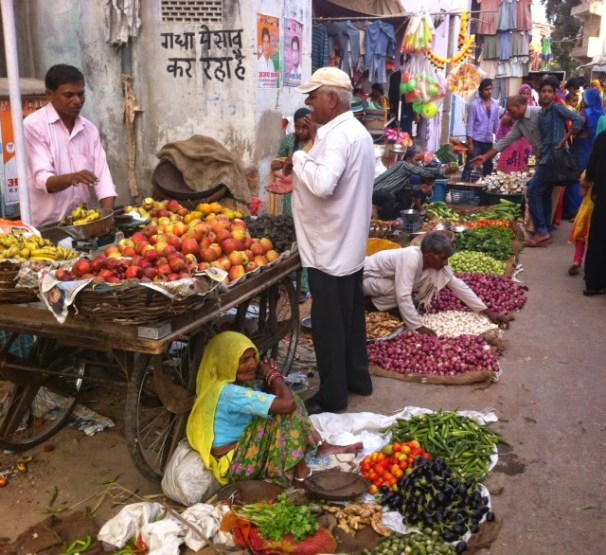
Produce is sold from wagons and directly at ground level.
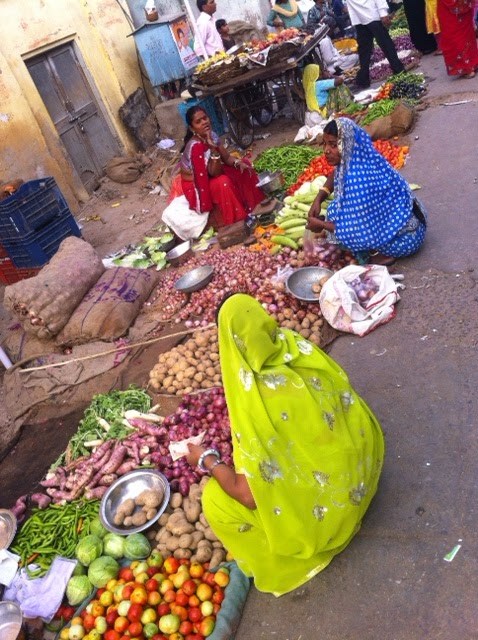
Even otherwise drab alleyways are transformed into richly colorful scenes from the women’s vivid colors. Why wear drab clothes when you can wear such gorgeous bright ones?
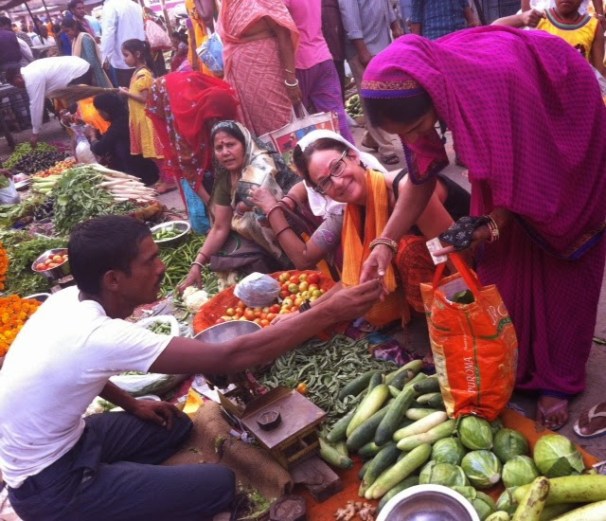
Peta is buying us some tomatoes for the road.

It’s easy to strike up conversations and connect with the women at the market place. Bright blue, pastel yellow, lime green and two shades of orange, make for quite a palette of colors.
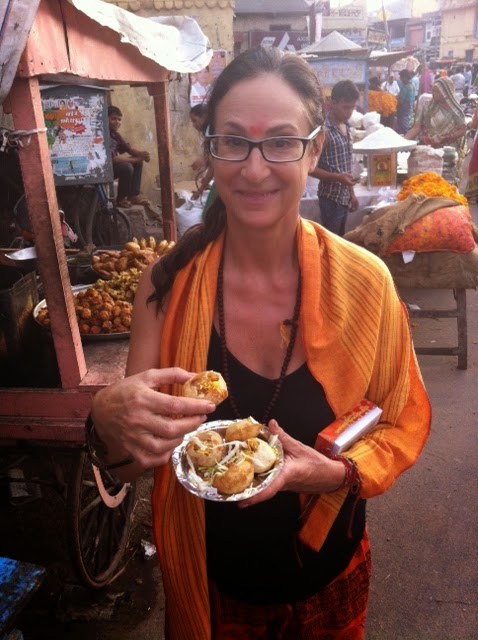
Probably our favorite Indian snack to eat at markets. A crispy round “shell”, filled with crunchy chickpeas and smothered in a yummy sweet and spicy sauce.
Market in Pushkar, India
By FAR, our absolute favorite place in India we have been to, is Pushkar, Rajasthan. In fact, so enthralled were we, that Ben wanted to stop traveling and just be living in the sacred city of Pushkar. We stayed about six weeks, and in was in intense experience to be sure.
Pushkar, like Hoi An in Viet Nam, remains for us a place we consider “home”.
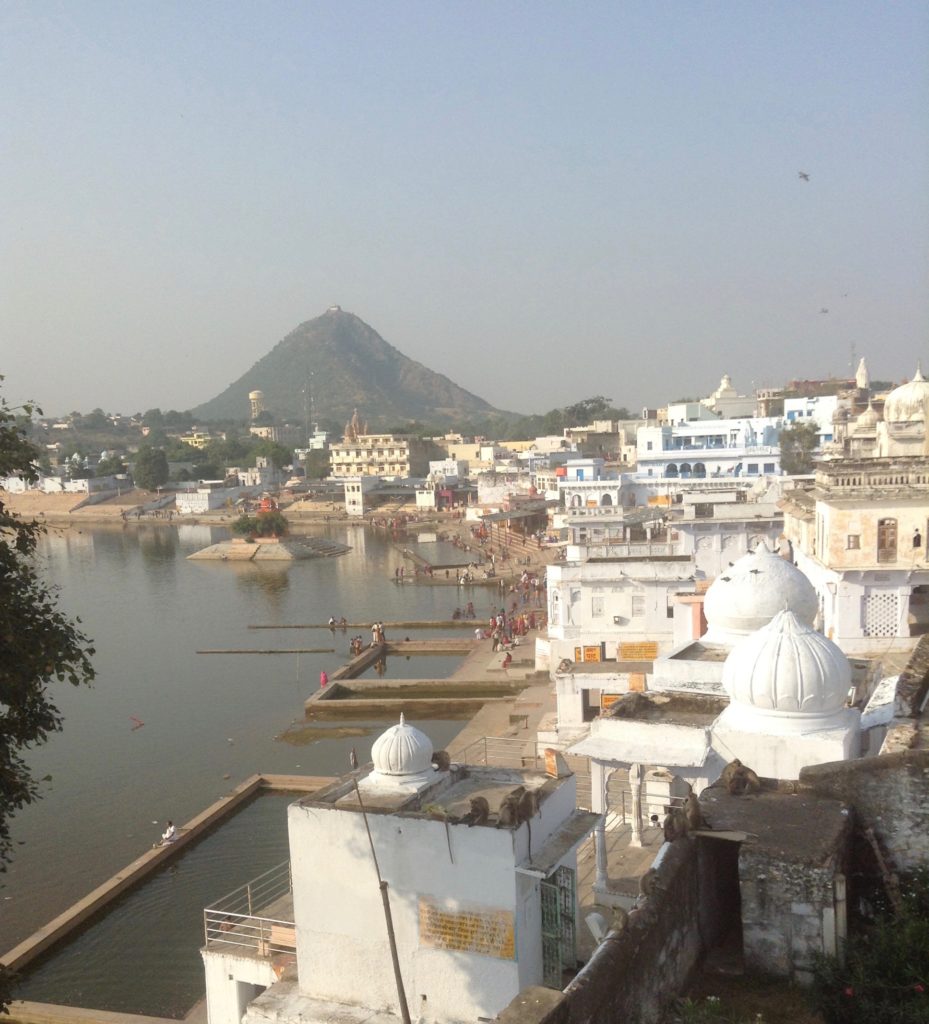
This was our view from our little room right on the Sacred Lake. Early morning prayers, early evening prayers, drumming.. and a constant flow of people coming to bathe in the holy waters. he mythology of the creator-god Brahma, whose most prominent temple stands in Pushkar. The Pushkar Lake finds mention on coins as early as the 4th century BC.
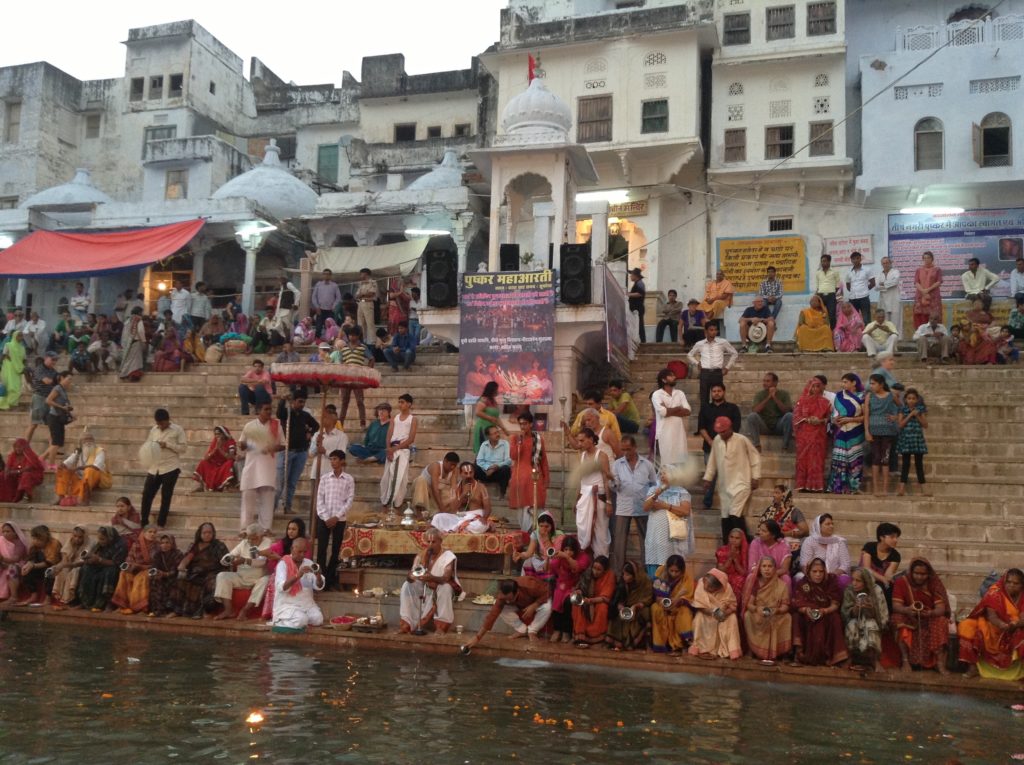
Early evening prayers on the steps of the sacred lake. Pushkar Lake is surrounded by 52 bathing ghats (a series of steps leading to the lake), where pilgrims throng in large numbers to take a sacred bath, especially around October–November when the Pushkar Fair is held. A dip in the sacred lake is believed to cleanse sins and cure skin diseases. Over 500 Hindu temples are situated around the lake precincts.
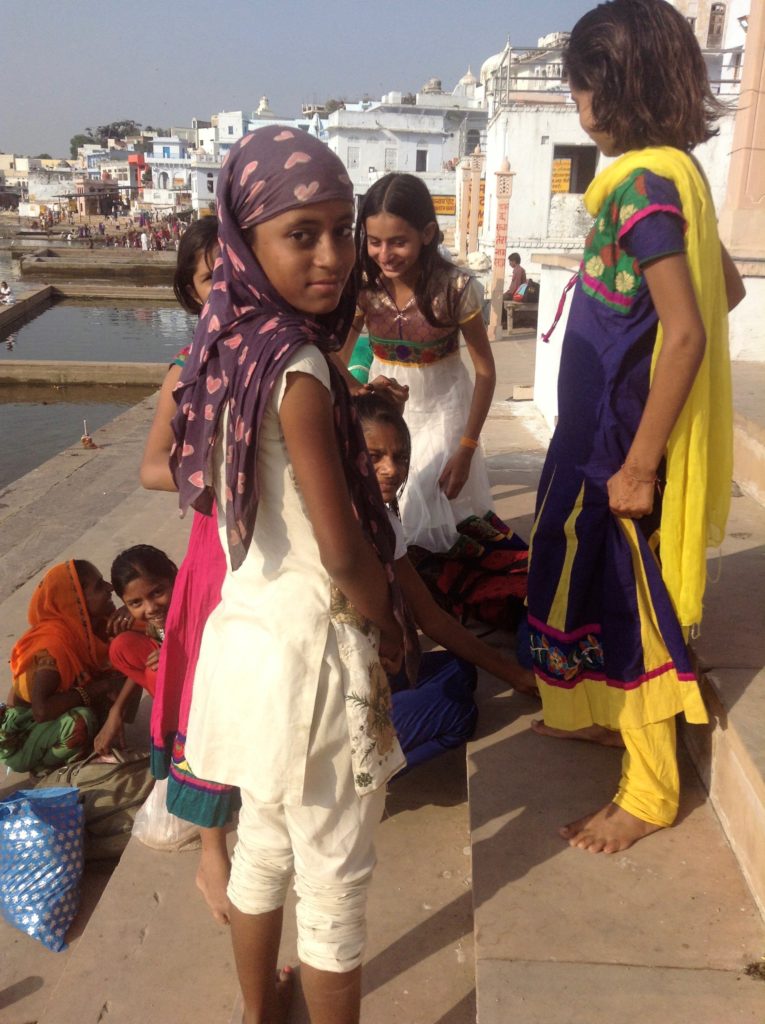
Young girls after their sacred bathing enjoy conversing with us. People come from all over the state of Rajasthan and the nearby state of Gujarat to these waters.
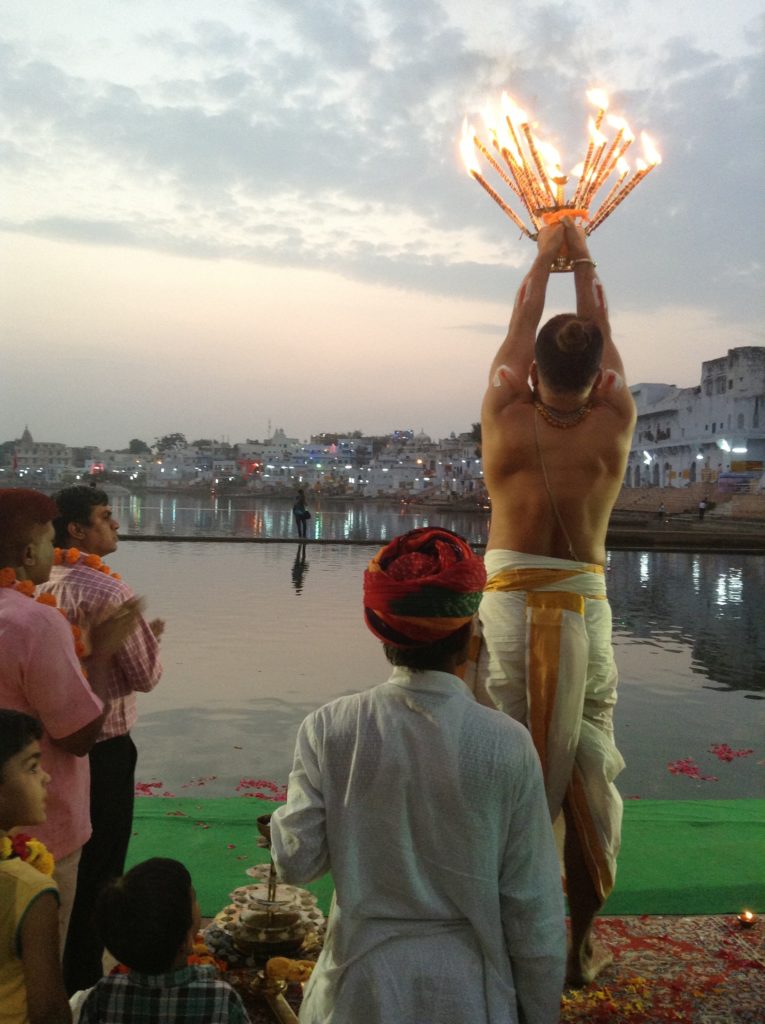
“Aarti ritual” at dusk ~The parallel prayers at different ghats in some cases augmented by loudspeakers, leads to a cacophony of simultaneous prayers. …

At the entrance to the sacred lake there is a market devoted solely to the sale of flower petals. These are used for devotional purposes by Hindu pilgrims. The colors are as vivid as the women’s saris.
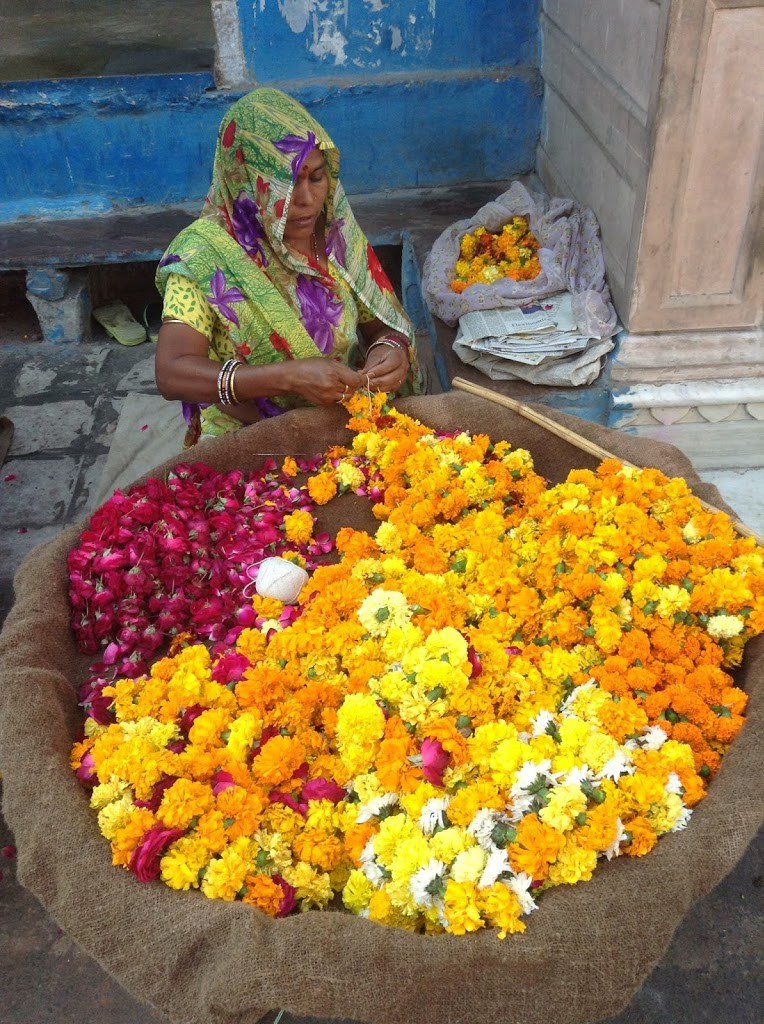
The intensity of colors, the mass of flowers, add yet another layer of visual impact.
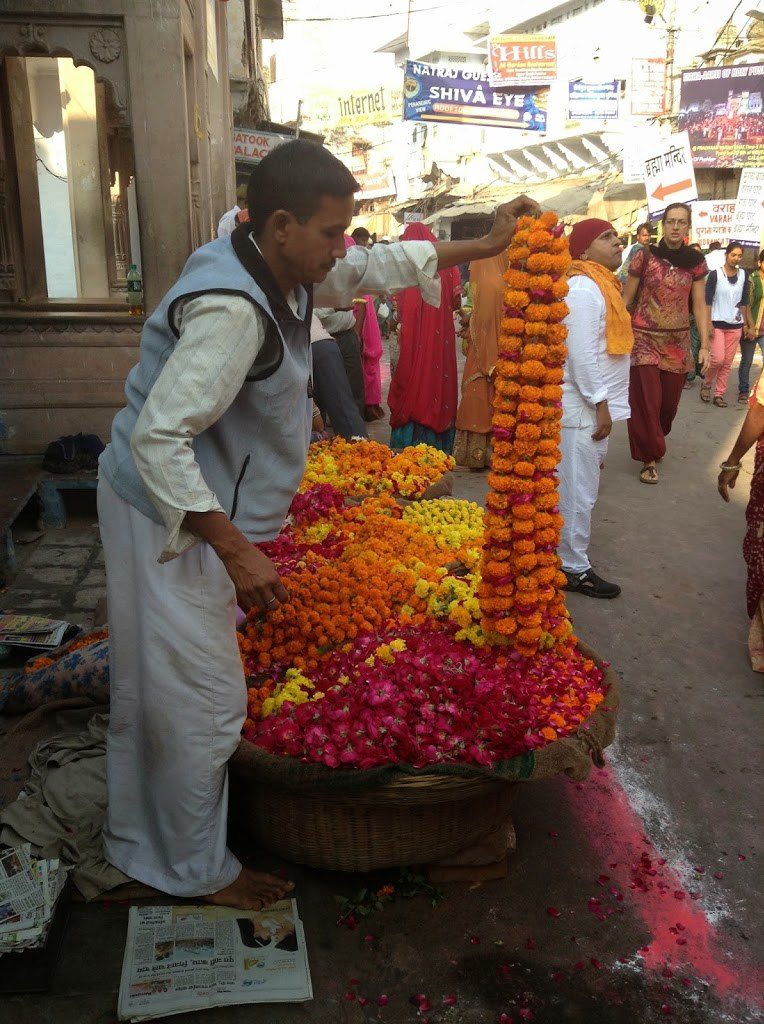
Here the petals of flowers have been carefully strung into a garland.
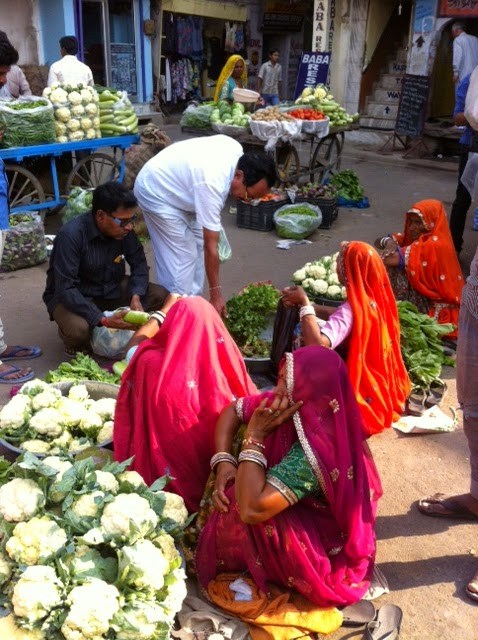
Close the flower market is the daily food market where women in brightly colored saris sit on the ground with their produced. The state of Rajasthan has both a large desert and fertile ground, yielding an impressive array of vegetables.

Pushkar is a vegetarian only city. Not even eggs are consumed or allowed. In fact, the “no meat allowed” is posted both in Hindi and English at the entrance to the town and is a rule that is taken very seriously.
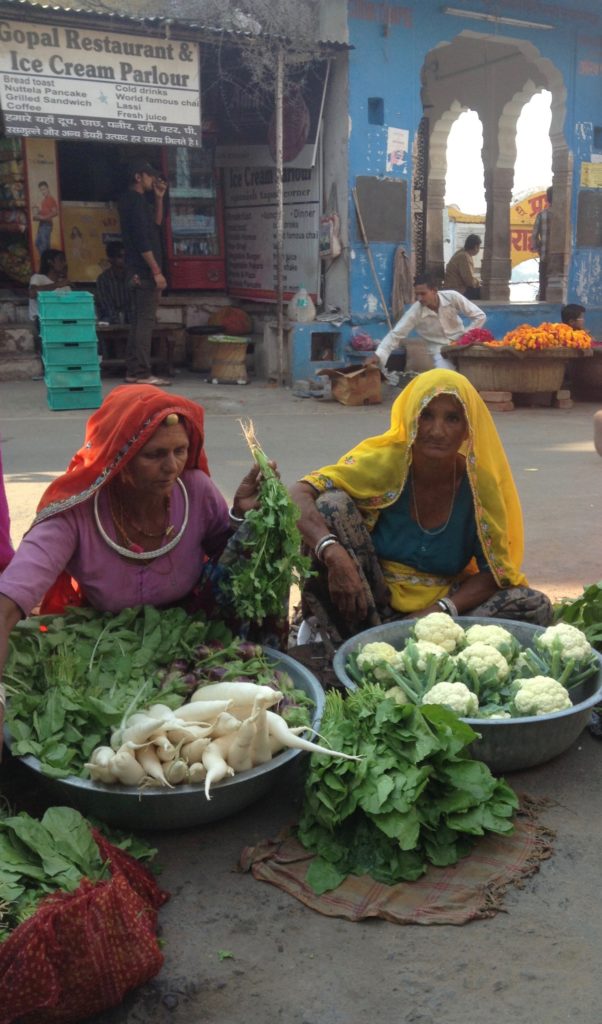
Delicious daikon and very large cauliflower for sale in these large big metal containers. No doubt destined for curry dinners at home.
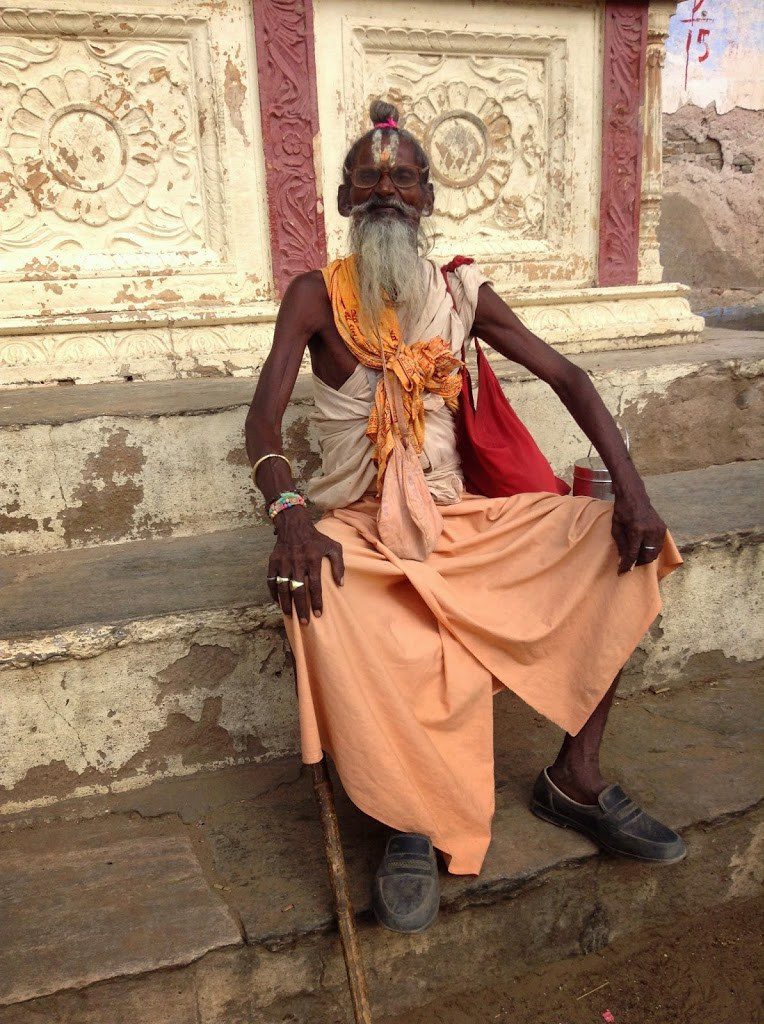
The”sadhu”, also known as “baba”, are holy men who renounce material possessions. Sadhus are wandering ascetics, highly revered as “close to the gods” and respected by all.
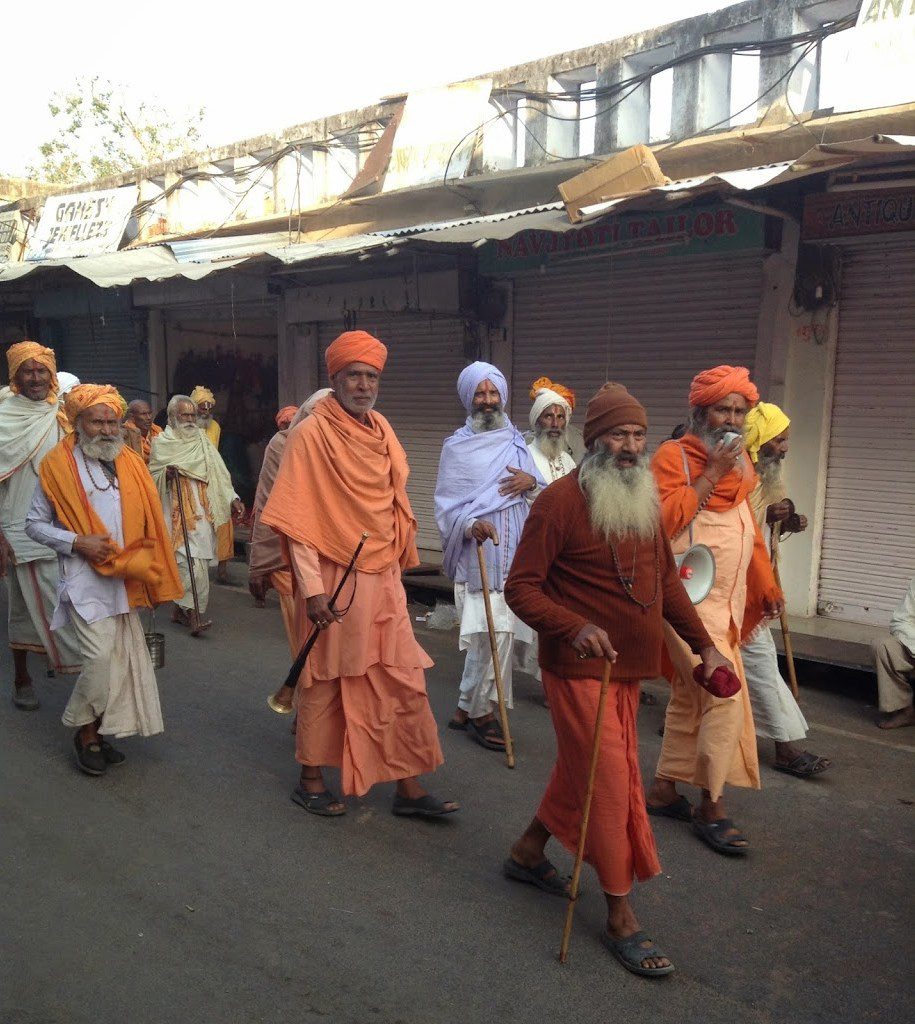
There are about 5 million Sadhus in India and Nepal. As we wonder the market place, the presence of these holy men makes this market unlike any other in the world.
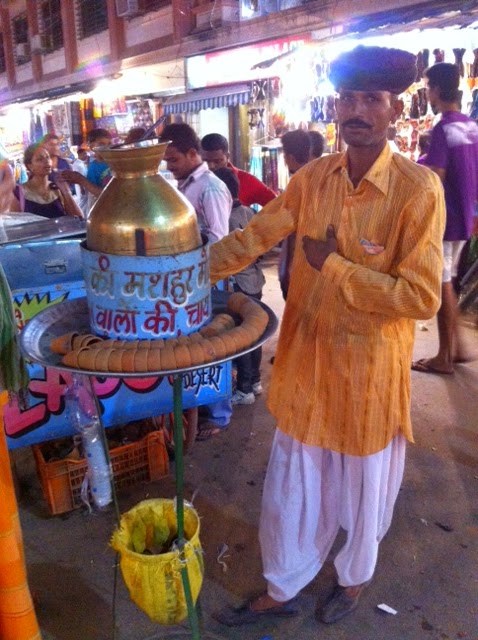
Ben is addicted to his morning hot chai (tea with aromatic Indian spices). Interestingly, the tea is served in the market, inside small clay cups which are used only once for this purpose. The clay itself adds yet another aroma to the chai and for this reason it is only used once.
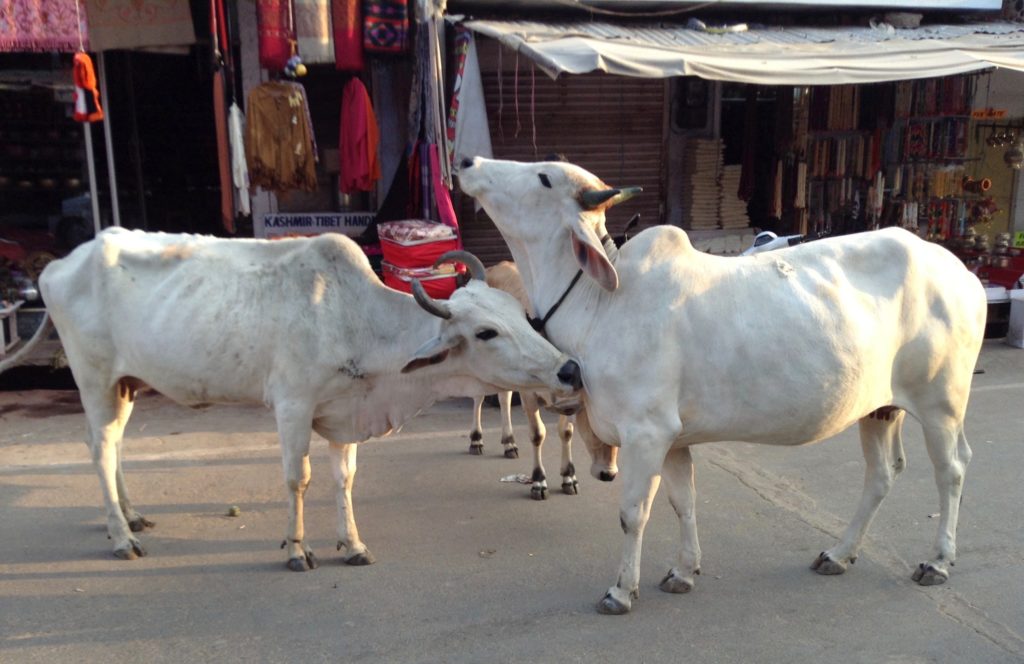
As we amble through the market we witness these very loving cows. Cows of course in India are considered holy and move freely without constraint. The problem is that many of them are hungry, especially in a city like Pushkar where there are not many grassy areas for them to graze. So they have a tendency to flock near the market area with the hope of scoring some greens.
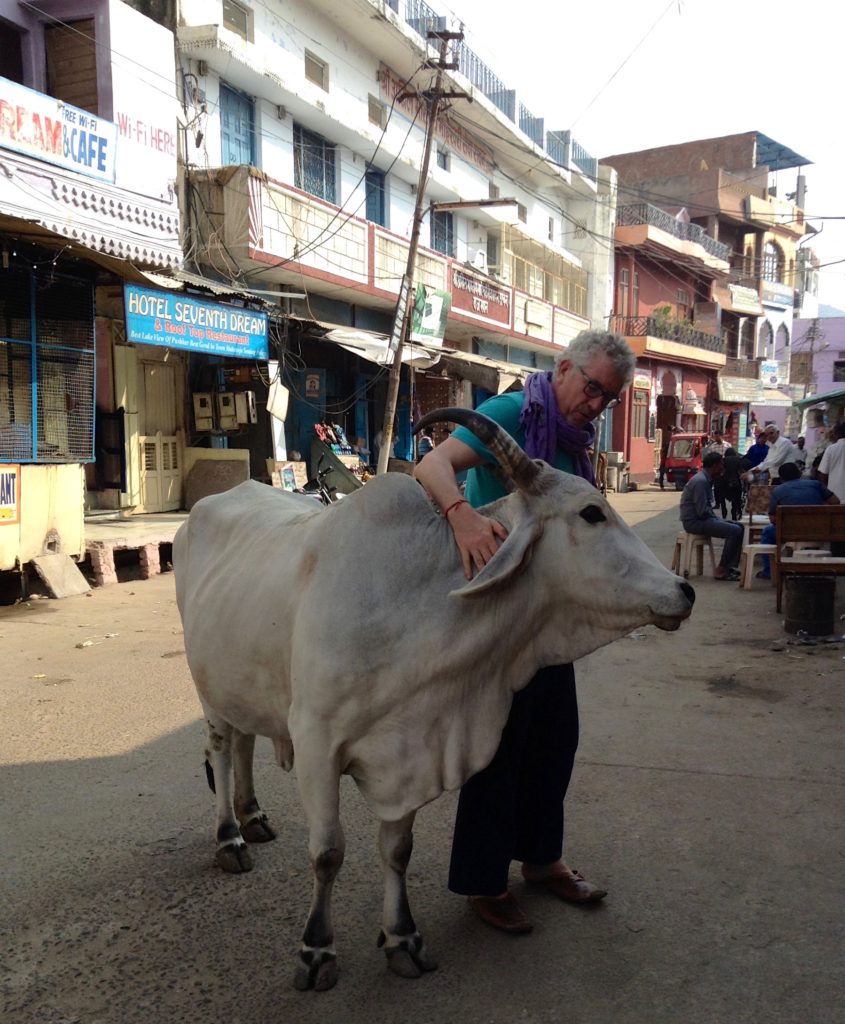
It’s a love fest!
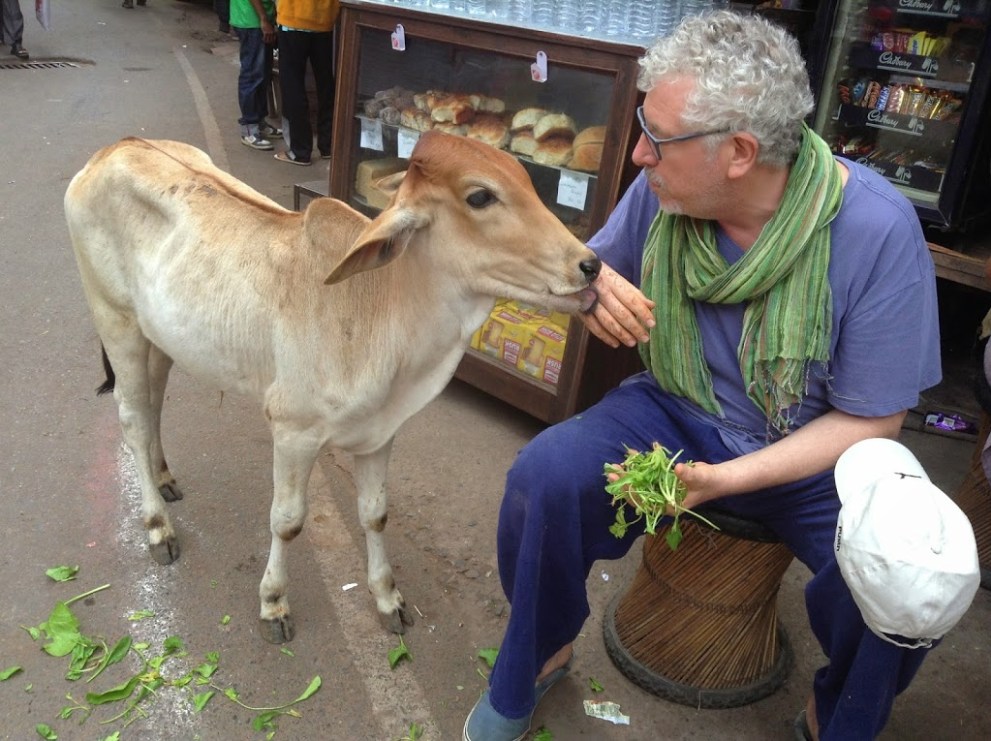
Locals were quite amused to see that we bought some greens from a vendor at the market in order to feed some of the cows. This little guy was very appreciative.

Peta is stoked with this unusual find at the market ~ natural pigments for paint piled up into soft pyramids of colors.

Heading home after a successful day at the market.

The most unique market we have probably ever been to, is this camel “fair” ~ a once a year market for the selling and buying of (primarily) camels.

Kids doing their best to sell Ben one of their dad’s camels.
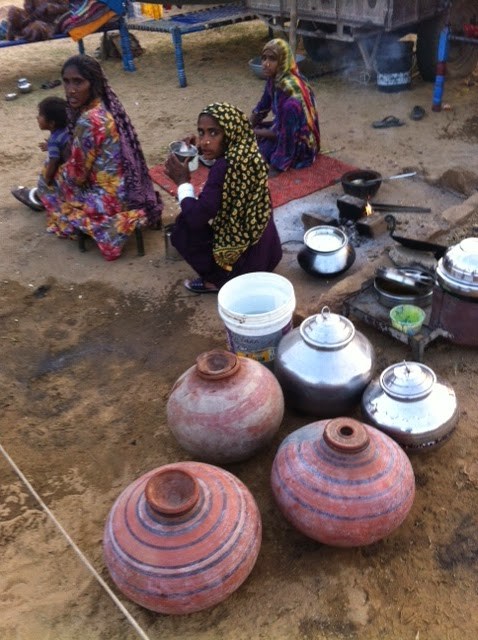
The men who come to the fair are interested either in buying or selling camels and livestock. The women, do what most of them do every day whether at home or “on the road” ~ go to market, prepare meals and care for the little ones.
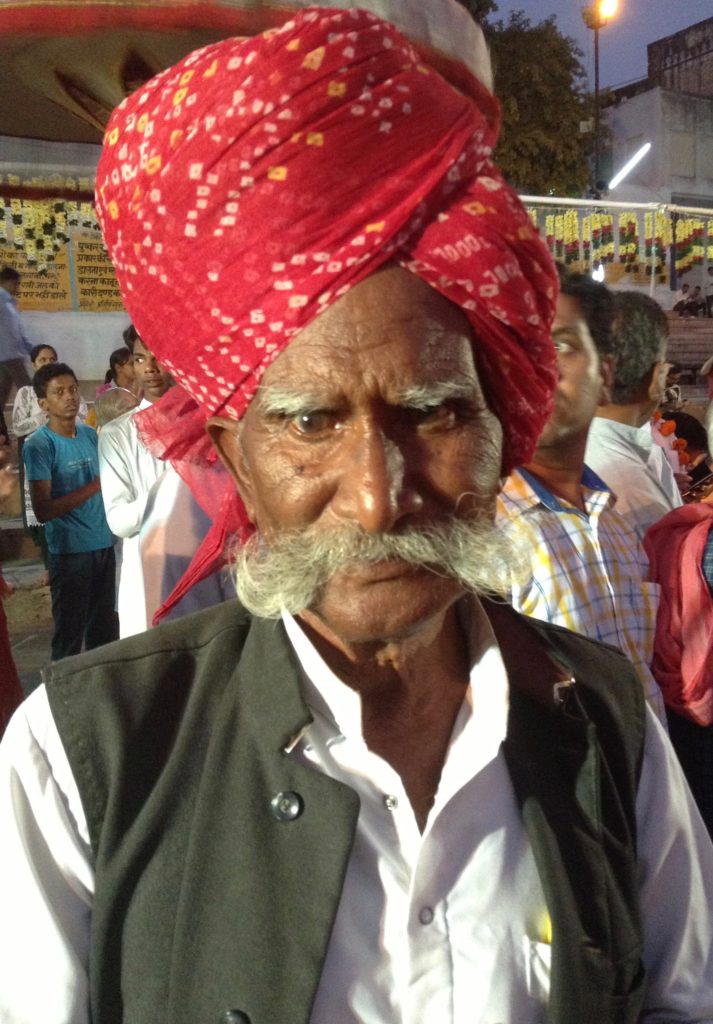
A Gujarati camel trader.
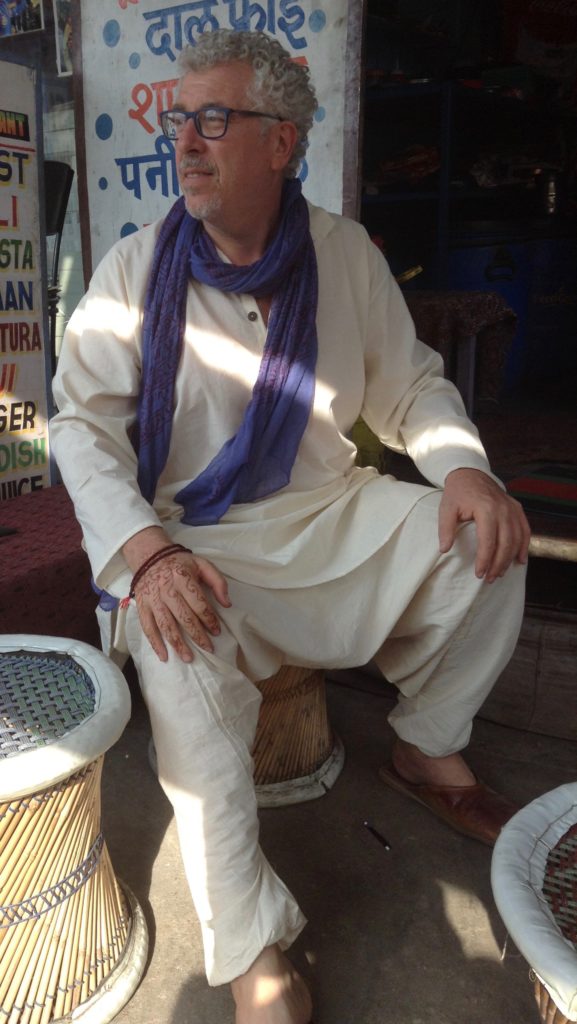
Ben, feeling very at home, in Pushkar.
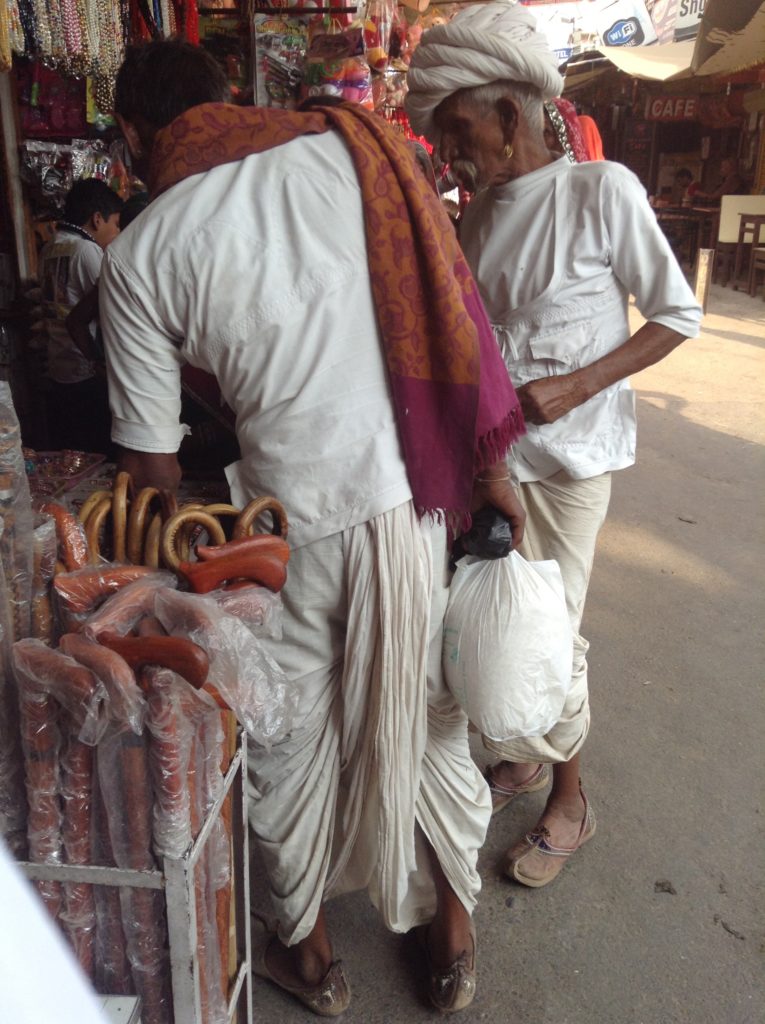
A very popular item sold at market to many of the Gujarat men are the handmade wooden walking sticks.

Gypsy women shopping at the jewelry market.
This fourth and final post on India concludes our retrospective series on Markets in Asia. For Indonesia and Hong Kong, see here; For Thailand, Cambodia and Myanmar, see here; For Viet Nam, see here.
Your post brings back many memories! We’ve seen some of the buildings you mentioned. In fact, we purchased wooden printing blocks from that very spot in front of the Palace of Winds. We spent more time in Nepal than in India, but people in both countries use strands of marigolds for decoration around doorways, windows, etc. Love the colorful markets and this post that brought it all home to me again.
Rusha, Nepal is one of the countries we are eager to get to… And yes, here in Sri Lanka, we have seen the beautiful strands of bright orange marigolds and white blossoms hanging in little stores near Hindu temples and around Ganesh statues.
Putting this post together made us both realize how much we miss India and that we are way overdue for a trip. And of course, living in Sri Lanka means it is very close by and an easy trip. This time we hope to explore the eastern coast of India around Pondicherry, which will be a new region for us.
Thanks for stopping by and commenting,
Peta
So much color, so much goodness. You two really capture the beauty and the essence of all these places with your photographs and stories.
I remember the Palace of Winds and the holy lake, but never went to the canal market. What an experience. And, I had no idea that Pushkar was a vegetarian town. I do remember seeing lots of holy cows. Your post makes me want to go back to India with my husband. Such an overwhelming country, though, but having lots of time to immerse ourselves in places like Pushkar, like you two did, will truly leave a positive impression.
Liesbet, the fact that Pushkar is a vegetarian town also means that there are quite a few really good vegetarian restaurants, many of which serve quite a variety of cuisines. India can definitely be overwhelming, especially the first time one goes there. We had a strategy of playing during the day and “staying in” at night catching up on emails, or our blog, so as to conserve our energy. But even so, the noise, the dust, the extreme poverty can all be crushing.
Thanks for the lovely compliment. What could be better than capturing the essence of a place?
Peta & Ben
I like that day/evening strategy you had in India. I went there in the nineties, so no internet yet.
Of course, I meant camel market instead of canal market in my previous comment. There were no iPads with autocorrect in the nineties either… 🙂
Most likely I will never visit this part of the world so it’s wonderful to see it through your beautiful pictures.
Thanks Janis, we are glad to be able to share with you.
Peta
The best yet! I love Indian food and the pictures of dhosa and channa have made me salivate. Yes, you’ve done it again….
Also, I had no idea there was such a thing as a completely vegetarian town. Wonderful!
Interesting to read that you liked this post on the markets the best. Haha, sorry about whetting your appetite every time, but I guess we are rather food focused individuals. Luckily for us we can still get a good dhosa here in Sri Lanka thanks to the Tamil community.
Pushkar is more of a town than a city, but your comment made us curious and we discovered this:
“Palitana, an Indian city has become the first all-vegetarian city in the world.
Behind this revolutionary change are the Jain monks who went on a hunger strike to pressure the state of Gujarat to outlaw animal slaughter in their city. The hunger strike was successful and the Gujarat government imposed a ban on animal slaughter and outlawed the sale of meat and eggs.
About 5 million people in India practice Jainism and agree with the ban.
Virat Sagar Maharaj, a Jain monk, says, “Everyone in this world – whether animal or human being or a very small creature – has all been given the right to live by God.”
As individuals, the best thing you can do to protect animals is to adopt a kind vegan lifestyle.”
Peta & Ben
I will have to visit there some day!
It’s waiting for you! And then you can stop in Sri Lanka, next door and come and visit.
P
A feast! Thank you. Wonderful pictures, I can almost smell the spices. What I wouldn’t give for a Pushkar cauliflower curry right now yum!
By the way those printing blocks are for fabric printing, done by hand traditionally. Saw it done once, in a back courtyard in Udaipur.
Haha Johnny, yup definitely some great vegetarian food to be had in Pushkar!
You are absolutely correct about the printing blocks. We will go back and edit that on the post. Yes, Udaipur has amazing fabric printing and dyeing workshops. We loved watching the process. It was spellbinding!
Peta & Ben
I love the markets of India. So much colour and energy. Thanks for these wonderful photos that bring back so many memories.
Peggy glad you enjoyed our photos and happy we could bring back such good memories. India’s assault on all senses is impossible to forget!
Ben
I have LOVED this series on Asian markets! To me, they are the best and most diverse in the world. Endlessly fascinating. And you’ve really inspired me to go to Pushkar — hopefully during the camel fair. Thanks for sharing such beauty (and color!) in your photos and words.
Thanks Kelly! Without a doubt Pushkar’s camel fair is one of the most intense sensory experiences we have ever had. Much more due to the variety of people who come through the desert from all over the region, than for the camels themselves. Although the camels are pretty cool too with the designs that are painted onto them for the occasion. One can just sit at a corner in town, sipping chai, and be in the middle of what feels like a technicolor 3 dimensional movie.
Peta & Ben
It’s an alien world to me, Peta, because crowds and noise are an anathema, but I’ve heard that the people are warm and welcoming. That lovely view down over the rooftops in Pushkar would be me, perched in my eerie. 🙂 🙂 Amazing scenes and thank you for sharing!
Johanna if crowds and noise are an anathema then any city in India is best avoided. However, Pushkar is actually quite small and when it is not the camel fair, it is a very peaceful, chill place to be. For me (Peta) I struggled with the dust as I am allergic to it and there were days that my throat was literally burning. The noise of the constant chanting, drums, people, did get overwhelming for me at times and then I did exactly that ~ retired to our little room or the open air lounging area.
As well, we had an amazing yoga teacher whom we went to twice a week at an ancient roof top temple, and that gave us the peace and quiet away from the madding crowd, that we needed. I also had lessons in Indian drumming and rajas singing ~ they were both super fun to have a shot at, although I am not naturally talented in either.
Peta
So did you buy a camel?! 🙂
Hahahaha… I definitely considered it!! 🙂
If you click on the link to the original post you can see how groomed and painted they ll were. Mighty tempting.
Ben
Oh my God, Peta and Ben, this post is such a feast. It so makes me want to go to India. I had to laugh when I read about the Pushkar camel fair. I have been obsessed with going to this since I first saw a documentary about it many years ago (Mike and my son don’t quite share my enthusiasm and I often get teased about it). Perhaps your glowing comments will change their minds.
Is it absolutely crazy there in Oct-Nov.? Is there a set date every year? Can you find a place to stay?
All your photos are amazing, colours are wonderful. I’m particularly impressed with the gorgeous architecture in Jaipur…the Palace of Winds looks fantastic.
Great post! Cheers, Caroline
Caroline thanks for your enthusiastic response to this post. You can tell Mike and your son that going to the camel fair, is definitely a once in a life time experience. One need not be that “into camels” as it really is all about the people.
Yes, it is pretty crazy, as some 400,000 people descend upon Pushkar and its surrounding desert, over a period of around 14 days. The date is usually in November each year, determined by the “Kartik Purnima”/ full moon. There are many different options regarding places to stay, from basic lodging to more luxurious. Because the fair lasts 14 days it is unusual for most people to stay more than a few days. However, it is of course a good idea to book ahead of time. One of the ways we avoided the “craziness” was that we did not go to the formal scheduled events which is where the crowds congregate. For us it was mostly about walking around the desert grounds where the nomadic tribes were camping and watching the people in town.
Thanks for the compliments on the photos! It was SO hard to select so few from the many great ones we have. Jaipur in our opinion, is a must.
Peta & Ben
Thanks for the info. I think I’m making some head way with my guys (at least with the old one). They were both impressed with your photos and quite liked the relative lack of camel images. They’ve both had unpleasant camel experiences, haha!
Caroline, I have to tell you though, there was one thing that did bother me with the camel fair and that was that some of the camels had one of their legs tied up at the knee, or two tied together. I expect it was so that they don’t run or run away but it definitely felt abusive to me and was upsetting. As well, many of the owners did not treat their camels the way I would have liked them to.. with more respect to their feelings, you could hear the unhappiness on the part of the camels. As we were there for the whole period of the fair, after the first few visits to the desert, I preferred staying in town for the festivities of shopping and daily prayers at the sacred lake.
Peta
What a cornucopia of color! I’m not sure what is most vibrant – the produce, the flowers, the saris, etc?! Loving all your market posts – just traveling and short on time for comments! 🙂
Thanks Lex, nice to get such positive feedback on all our market posts.
Peta
India…I long to visit it, yet it scares me a little. Maybe I need to become a more “seasoned” traveller before I take the plunge? This collection of 4 posts has been fascinating, I have certainly learned a lot.
I hear of people being worried about eating street food in India, because of hygiene issues, stomach problems etc. How did you find it? Were you worried at all? I love Indian food, so it would be food heaven for me there. Pushkar sounds like an amazing city, I did not know that meat was banned in some cities in India? Thank you for another great post 🙂
Gilda these are some good questions you have. We have always said that once one goes to India, traveling elsewhere can be “mundane” in comparison and for that reason we do think it is good to be a seasoned traveller first. For example, we went from India to Istanbul Turkey (for the first time) and it frankly felt rather drab after India. To be sure Istanbul is a wonderful destination with fantastic architecture, but the juxtaposition after India, made it pale in comparison. How one experiences a place is always relative to where you are coming from and where you have been.
Our strategy for street food in India and everywhere is to see where the locals eat and we choose the most crowded spot because that means not only is it good but the food moves quickly and therefore less risk. (This applies to any country anywhere.) We avoid precooked foods that have beens standing for hours, and rather look to see where food is being made “real time”. We also take note of the areas where the food is being cooked, which in India are often visible. Many times even though the environment around the restaurant or food stand might be dusty and not clean, where the food is actually being prepared, we often found, was absolutely spotless.
When we came to Delhi the first time we told ourselves in the plane that FOR SURE we would not be eating street food, but within a few hours of landing we had our first delicious breakfast on the street. Impossible to resist. We have never gotten sick eating street food in India. There are also many small restaurants everywhere serving up delicious food to locals.
We always look for fresh ginger at markets so that we can have it with us, just in case we do get a stomach bug.
Peta & Ben
Such fascinating sights – that glorious Palace of Winds, the bounty of fruits, flowers, and vegetables, the cows and camels – did Ben buy one? He looks like he should have a camel. My favorite photos are always of the people. They are so expressive and beautiful. It ‘s been a wonderful tour of all these markets, wish I could go visit in person.
Thanks Shari for such glowing compliments. So glad you liked these posts on the markets so much. Ben was mostly in love with the cows more than the camels, haha. One of our fond memories of the first time we visited Pushkar was when we stayed in a luxury tent on the edge of the desert for a night. We wanted to go for an early morning exploration of the surrounding desert. A staff member came by to announce that “Sir, your camel is ready!” Not something one hears every day…. 🙂
The camel fair is a bit of a misnomer. While the camels are the big attraction, there is a culture around these parts for raising gorgeous pure bred horses. The horse trading “side show” was also fascinating.
Peta & Ben
And the paint pigments – love these – I’m an artist and would love to indulge in such a treat.
I still have these and have been meaning and meaning to use them… sometimes when one buys something “special” there can be a reluctance to want to use it up. But I will do so some day…
Peta
Super pictures! I love the Hawa Mahal. I don’t suppose Ben BOUGHT a camel, but was he tempted?
Thanks Aaron! Yes he was tempted, you know Ben, but I just had to put my foot down!
Peta
I am in awe. Of you and Ben. Of the places you show us here. Of the colors and the tender lined incredible faces of those you captured on your camera. Of the life that is ongoing far from me but just as real. Of the importance of spirituality and the sense of wonder that the people in these places seem to revere. Of the food markets. Of the idea of a town/city banning meat. I’m in awe of it all.
THANK YOU.
Wow wow! Thanks Pamela for the beautiful comments, so eloquently expressed. So nice to have such an appreciative audience.
These are all amazing places and we haven’t regretted one moment since we left our “normal” life (ten years ago) when our youngest graduated high school.The more we travel, the more we learn, the more we realize how little we know of the world and the rich tapestry of ethnicities and cultures that awaits us.
Pamela, you are quite right about a different order of magnitude of spirituality in the sense of rituals and belief systems that permeate peoples daily lives in ways that are very different to what we are accustomed to in the West. There is no preachiness here about “my god is better than your god”, there is just a fluidity about life and death and ancestors and divine influences and ancestral practices that constitute a culture in each place we visit.
Furthermore, the abstract construct of nation states doesn’t really apply in such a huge nation as Indonesia comprised of so many islands or in a continent such as India, which is enormously complex with a multitude of languages and local histories. It is too simplistic to fall back on the nation state. The richness of Pushkar differs meaningfully from the richness of the city of Jaipur, also in the state of Rajasthan. And the India one finds in Rajasthan is meaningfully distinct from the India one finds in Kerala in the South. All that to say, that if numerically there are only 197 countries in the world, there is in fact an infinite number of micro ecosystems each with its own fascinating set of visuals and cultures and as you say “tender lined incredible faces.”
Peta & Ben
And then, sometimes, I think of the infinite number of micro ecosystems within each of us, individually!!!
Thanks for opening up my insight to the world and each other. Hope all is well with you both.
Thanks Pamela.. we have been away from blogging for a while… had some travels to family in various parts of the world. Finally we are back!
Peta
Fabulous post you two, with some great photos! We also were in Pushkar for the camel fair and absolutely loved it. My sister spends time there every year. I think Pushkar and Varanasi are my favourite places in India.
Alison
Thanks Alison! Your sister goes to Pushkar every year for the camel fair? Where does she travel from?
We have yet to go to Varanasi, but hopefully we will soon, India is an easy short flight from Sri Lanka.
Peta
No, not for the camel fair. Travelling with us the camel fair was what got her there in the first place and she got hooked on India and Pushkar. She has established friends there and spends several months at a time there. Among other things she does photography for a new school established by expats for the Kalbelia (gypsy) children. She travels from Australia.
How very cool. Nice to hear about a school established for the gypsy children. Ben was “pushing” for living in Pushkar for a more extended period of time. (For me, my dust allergy made this a problematic idea). Ahhh photography skills run in the family, eh?
Lucky for me two of my three sisters have been/are professional photographers and taught me everything I know.
Great site and wonderful pictures. I can smell the spices. India is a place close to my heart.
Thanks John for the compliments, always nice to hear. Thanks for stopping by to read us and comment.
Peta
The colors are sumptuous – and everywhere color. It’s wonderful.
Question: How do you decide when to cover and not cover your head when in public? I notice that in many pictures it’s covered and in many it’s not.
The head and shoulder covering is situational. Certainly required when entering a mosque (there is a very large Muslim population in India, even though it is still a minority). In Hindu temples, it is the opposite, one has to remove anything from the head, but shoulders need to be covered. And then, in non religious sites it is a matter of feeling out the environment. I usually wear a scarf on my shoulders, and if the majority of women have their head covered it often feels more comfortable to me, to be covered too.
Thanks Judith for the lovely feedback re the colors! It does feel like being in a technicolor densely saturated color movie.
Peta
What an incredibly vivid and colorful culture! I’ve never heard much about Pushkar, but it looks fascinating.
Dee we visited Pushkar the first time we were in India, years back and vowed we would return one day for the camel fair. It was very satisfying to get back there and spend extended time in this vibrant and unusual place. What is interesting, is that the core of Pushkar has a thousand year history and strict limitations on construction and even though it has become built up around it, with new hotels etc, the core remains intact and the same today and the same as it was ten years ago, and probably hundreds of years ago as well. It is good to know that if we return in ten years, it will most likely be the same at its core.
Peta & Ben
SOOOOOOOO much to say.
1. Amazing
2. Blows my tights off
3. The camels. OMG. I want one.
4. deep aborigine eggplants. YESSSSSS.
5. The women. Stunning in their dress
6. “YOU,” Peta are INTERESTING and fabulous.
7. The camels! LOL
8. The fruit, vegetables, colors
9. The face of that camel trader is CLASSIC & Must be framed!\
10. Inspiring.
xx
Kim thank you for the 10 pointer feedback. You gave us both a good chuckle this morning! Always nice to hear that a post is inspiring!!
I’ve heard camels do not make good pets at all, you might want to rethink that, haha.
xoxo
P
The Camel Festival at Pushkar is truly amazing. I’m glad you witnessed it. The markets in India are majorly unorganized and hence you find everything and anything under the Sun! I like how you have captured the essence and variety of the markets.
Cheers, Charu
A mesmerizing visit to Mumbai and Pushkar, Peta and Ben. I sit in my quiet room and you take me away on a magic carpet to such an exotic and fascinating place, thank you. The photos speak volumes, and I study each one. This way of life, one that you have so admirably adopted, is a beautiful one. Thank you–
Jet so happy to provide you with a magic carpet to foreign lands. It is a low carbon mode of travel 🙂
Thank you for your very lovely comments.
Peta & Ben
What a treat for the senses! Your words and images capture the essence of Indian markets so well. I am yet to visit Pushkar. Hoping to explore more of Rajasthan next year.
Thanks Madhu for your lovely comments. So glad you feel that we were able to capture the essence of markets in India. That is compliment indeed.
Rajasthan is magical any time, but if you happen to have the flexibility to make it November, then the Pushkar camel fair is a rare treat and kaleidoscope of colors and nomadic culture.
Peta & Ben
So great to see someone is experiencing everything 🙂
Thanks for stopping by Green Global Trek to read us and comment.
Peta
How sweet that you fed some of the cows at the market. Your photos bring back fond memories of the Jaipur market streets filled with spices, jewelry, and so many colorfully dressed locals.
Very lovely. 🙂
What I love about your blog, Peta and Ben, is the every day photos of your travels. Love how you manage to capture the everyday bustles of the places wherever you go – and seeing the two of you going about like locals do and blending in gives us a very real first-hand look of different places.
From what you described, feeding the cows doesn’t seem common over there. Maybe feed one, and the others will get jealous and come for you. That’s what happens when you try to feed the birds here in Australia. But doesn’t look like Ben was swarmed 😀 At first I thought those piles of paint dye were colourful top hats! Peta looks so happy at the sight of them, and hope you walked away with some of it 🙂
Thanks Mabel, those are indeed for us the best moments of our travels… We do not make good tourists but we do enjoy getting the most authentic experience that we can, with the limitation of course of being an outsider.
The cows are definitely not used to being fed something green and yummy, they have to fend for themselves, so some of them are quite shy. But being “swarmed” by cows would make any day a good day for Ben! He once spent almost an hour lying in a field with a baby calf in Central Viet Nam and I had to ply him away.
http://www.greenglobaltrek.com/2014/05/day-6-and-7-ho-chi-minh-trail-getting-into-lak-lake-region.html
Yup we did buy some of those paints 🙂
Peta